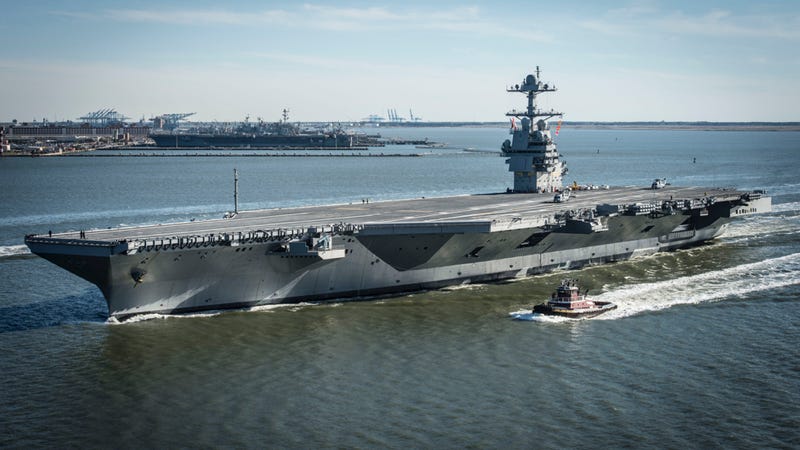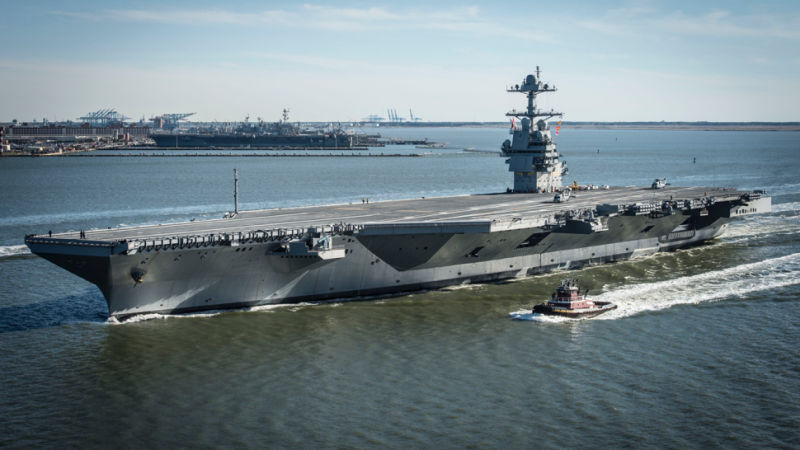
The modern aircraft carrier is a global symbol of American dominance, hegemony, peace, even empire. But at over 1,000 feet long, and displacing more than 100,000 tons, is it a sitting duck? Is the massive emblem of American greatness just an obsolete, vulnerable hunk of steel?
Advertisement
There’s a lot of consternation about whether or not the United States should even have massive supercarriers anymore. Obviously, the answer here is “depends on how much explosives you’ve got.” But while sinking an aircraft carrier is difficult, it’s not impossible. The key is what it’s used for, and who it’s used against. But if you wanted to sink one, here’s what you’d have to do, and what you’d be up against.
(Professor Robert Farley is a specialist in military diffusion, maritime affairs, and national security at the Patterson School of Diplomacy and International Commerce at the University of Kentucky. He took exception to our original piece on carrier vulnerability, and seeing as how he’s an expert, we offered him a chance to do us one better. – M.B.)
A History Of The Modern American Aircraft Carrier
The U.S. defense community has debated whether or not aircraft carriers are a bit pointless since the late 1940s. In World War II, aircraft carriers became the decisive weapons of naval warfare. Technological developments at the end of the war put the carrier’s survivability into question, however. Precision-guided missiles (unmanned Kamikazes, in a sense) and high performance “true” submarines threatened to make carriers impossible to defend, especially in combination with nuclear weapons.
Advertisement
Nuke a carrier, and it’s sort of game over, really. Nuke anything and things tend to be over.
The first crisis over the future of the carrier came with 1949’s “Revolt of the Admirals,” in which the U.S. Air Force argued that aircraft carriers were so vulnerable that they represented an unwarranted expense; the Navy’s admirals, as the name suggests, practically revolted at this idea.
Eventually the United States would build its Cold War navy around families of “super-carriers,” each over 1,000 feet long, that began with USS Forrestal (CV-59) in 1955 and continues to this day with the USS Gerald R. Ford (CVN-78).
Advertisement
Sponsored
These ships have become extraordinarily expensive, and they concentrate an enormous degree of firepower in one (potentially vulnerable) platform. Both during and after the Cold War, plenty of analysts – not to mention taxpayers – criticized the Navy’s fixation with the huge ships, and suggested that smaller, cheaper vessels could perform many of the same tasks.
For their part, the Soviets spent a great deal of time and money figuring out the best way to kill American carriers, especially after the Navy equipped its carriers with nuclear weapons. Today, China’s system of anti-access systems has made U.S. carriers the focus of its attention.
The Importance Of Aircraft Carriers
The core problem for every system dedicated to sinking aircraft carriers is the link between reconnaissance assets, or the things that can spot a carrier, and shooters, the things that can take one down. Submarines, aircraft, and surface vessels can’t kill carriers at range if they don’t know where those carriers are, and one of the notable differences between an aircraft carrier and an airbase is that the former, obviously, is mobile.
Even a supersonic cruise missile can take twenty minutes to reach its target area at maximum range, and a carrier maneuvering at high speed can move ten miles in the same period of time. A massive aircraft carrier can move surprisingly fast for something weighing over 100,000 tons, with a top speed of more than 30 knots, or about 35 miles an hour, which is what you get when you go for nuclear power.
The problem is complicated by the fact that the surface ships and submarines firing at such ranges cannot detect the carrier themselves; they need to operate off data provided by other assets, which tends to increase the time and uncertainty associated with targeting decisions. The United States has spent, essentially, 30 years developing and working out a reconnaissance strike complex that includes multiple redundant systems of surveillance and communication, resulting in a kill chain that transfers information in real time from advanced sensor platforms (satellites, submarine listening posts, drones, patrol aircraft) through communications nodes (satellites, aircraft) to ships, planes, and submarines that can launch and guide missiles to targets.
No other country has similar capabilities, even Russia and China.
Advertisement
Advertisement
Nevertheless, the Russians and the Chinese continue to try. Here are some of the measures that foes have taken to destroy aircraft carriers, and the countermeasures intended to defeat those foes.
THREAT: Torpedoes
No aircraft carrier has ever been hit by a modern torpedo of any sort, so we lack good evidence on how resilient a 90,000-ton ship might be to this kind of attack. The Navy tested a variety of underwater attack mechanisms against the retired Kitty Hawk-class carrier USS America in 2005, but the exact nature of the tests, and their results, remains confidential.
In World War II, submarines sank a total of eight fleet carriers from Japan, the United States, and the United Kingdom, beginning with HMS Courageous in 1939. And during the Cold War, the Navy identified Soviet nuclear submarines as a critical problem for carrier battle groups. As evidence from exercises indicates, submarines continue to pose a threat to aircraft carriers. To kill a carrier, a submarine needs to avoid escorts and patrol aircraft by either remaining stationary and waiting for a carrier to happen along, or by approaching a carrier quietly. In the open sea the latter is a difficult task, as carriers move at roughly the same speed as modern subs.
Navies closely guard the effective ranges of standard homing torpedoes, but most sources agree on 35 to 40 miles at maximum. Modern torpedoes explode underneath a ship in order to break its back and cause extensive, fatal flooding. The Russian Navy has developed extremely fast “supercavitating” torpedoes, but details on their operational status and practical effectiveness remains thin.
Counter-measures
The main solution to the submarine problem is to prevent submarines from moving into attack positions. Historically, this has involved multiple ways to detect and destroy enemy submarines, including carrier-borne anti-submarine aircraft, helicopters launched from escorts, land-based aircraft, and escorts themselves (including both surface ships and submarines).
Advertisement
Advertisement
During the Cold War, the Navy had enough confidence in its ability to find and kill Soviet subs that it could envision using carriers in major offensive operations against Soviet territory in the Arctic and in the Pacific.
The Navy’s anti-submarine warfare (ASW) capability has decayed since the Cold War with the retirement of the S-3 Viking patrol aircraft and the Oliver Hazard Perry class frigates, but then Russia has fewer subs than it did during the Soviet period, and China’s long-range nuclear submarines are considered relatively loud and easy to track. Quieter diesels lack the legs to remain on station in the areas that aircraft carriers will operate, and the speed to keep up with the battle groups.
Submarines are not as easy to link into a system of command and control as aircraft and surface ships, either, and hence tend to react more slowly to intelligence. Nevertheless, a sufficient number of carefully deployed submarines can pose a significant threat to any carrier group. If all else fails, most submarines and surface ships carry a variety of counter-measures designed to confuse homing torpedoes. These include noisemakers and decoys intended to distract the torpedo; the Russians and Chinese have wake-homing torpedoes designed to defeat these defenses.
THREAT: Cruise Missiles
The first naval cruise missiles saw duty in World War II, when German aircraft used precision-guided glider bombs to attack Allied and Italian ships. In the Cold War, the Soviets developed an array of platforms to launch cruise missiles against U.S. carrier battle groups, including submarines, surface ships, and aircraft. The USSR developed the Tu-22M “Backfire” bomber specifically to conduct cruise missile attacks against Navy carrier battle groups.
Advertisement
China has taken a similar approach, using a variety of different cruise missiles launched from different platforms to threaten US carrier groups. Most of these missiles travel to their target near sea level in order to avoid detection, popping up towards the end of flight in order to inflict maximum damage. This profile makes the missiles difficult, although not impossible, to engage with surface-to-air missiles and defensive fighter aircraft. Most cruise missiles require programming at launch, getting them to a specific area before they can identify and select targets on their own, but some missiles have more advanced systems that allow them to detect and discern between targets at long range.
Counter-measures
As with torpedoes, the way to avoid cruise missile attacks has been to prevent platforms from coming close enough to aircraft carriers to reliably launch their missiles. For surface ships the problem is relatively simple, and few expect that Chinese or Russian surface vessels can close to within reliable firing distance of a U.S. carrier before being destroyed, what with the wide-reaching net that American naval aviation can cast far in advance of a carrier group. Cruise missiles complicate the threat posed by submarines, but the principle remains the same; destroy the submarines before they can close within firing range. Aircraft launched cruise missiles (ALCMs) pose a different problem, as aircraft (due to altitude and the curvature of the earth) can identify a carrier group from greater distance than a sub or ship. To defeat aircraft, carrier groups rely on a combination of surface-to-air missiles (launched from Aegis cruisers and destroyers) and fighters flying combat air patrol.
Advertisement
In the Cold War, this evolved into a complex game between the U.S. and the USSR; the Soviets needed good intelligence to justify the launch of a large number of bombers, many of which they expected to lose. The Navy developed decoy techniques to trick the Russians into launching mass sorties, intended to gut Soviet capabilities and deter the Soviets from launching at all. The Navy developed the F-14 Tomcat to counter the threat of ALCMs; with a big radar and a long range air-to-air missile AAM, the F-14 could provide distant protection for a carrier battle group.
The Navy no longer operates F-14s, but the carrier air group still has combat air patrol responsibilities that include not only the destruction of attacking bombers, but also any drones and patrol aircraft that can report real-time data on the location and orientation of an aircraft carrier.
Advertisement
No cruise missile has ever struck an aircraft carrier, although missiles have had mixed results against smaller warships. Anti-ship missiles were used extensively during the Iran-Iraq War, and generally failed to sink large oil tankers. But a cruise missile can cripple a carrier by damaging its flight deck, even without sinking the ship.
THREAT: Go-Fast Boats
While the threat that small boats pose to major warships has been apparent for some time, the Pentagon’s Millennium Challenge 2002 exercise brought the issue to mainstream attention. In that controversial exercise, small fast boats carrying suicide payloads inflicted heavy damage on U.S. naval forces. “Red” strategy built off of the successful Al Qaeda attack against the destroyer USS Cole in 2000, as well as the history of Iranian small boat operations during the Iran-Iraq War.
Referees eventually prohibited some of the most effective Red techniques in order to give U.S. forces a fighting chance. Even a heavily laden suicide boat would struggle to sink a supercarrier, but they could give the crew a very bad day and reduce the ship’s effectiveness for an extended period of time.













